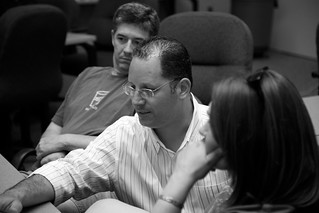 A study was released about 5 days ago. The title: The Advantage of Abstract Examples in Learning Math. A number of articles about it share the title" Concrete examples don't help students learn math, study finds. (Supporting material can be downloaded as a pdf here.)
A study was released about 5 days ago. The title: The Advantage of Abstract Examples in Learning Math. A number of articles about it share the title" Concrete examples don't help students learn math, study finds. (Supporting material can be downloaded as a pdf here.)
From the article:
Teachers often use real-world examples in math class, the researchers said. In some classrooms, for example, teachers may explain probability by pulling a marble out of a bag of red and blue marbles and determining how likely it will be one color or the other.But students may learn better if teachers explain the concept as the probability of choosing one of n things from a larger set of m things, Kaminski said.
If Ms. Kaminski (one of the authours of the study) tried this in any high school classroom she'd bang up hard against a confused wall of silence from all except the most gifted students.
About 2500 years ago Aristotle wrote about how presenting an argument from the general to the specific (deduction) is only one of two forms of presenting information (teaching). Arguing from the specific to the general (induction) is the other. Both have their place.
Anyone who has taught mathematics in a high school classroom knows kids really need to learn and understand both. Often, they just can't grasp general concepts until they have seen several concrete examples. This is what Aristotle calls induction. It is a weaker form of argument than deduction (arguing from general principles to specifics) but is a necessary step in the learning process. Generally speaking, kids find inductive arguments far more compelling than deductive ones, even though the reasoning behind deductive arguments is far more sound.
One of the authours of the study also said:
Story problems could be an incredible instrument for testing what was learned. But they are bad instruments for teaching.
 Sometimes a study is just plain wrong. This one is just plain wrong. "Story problems" are excellent tools for both teaching and learning, particularly when students are taught to recognize the underlying patterns of the general mathematical ideas they contain. I find teaching mathematics is something of a dance; constantly flipping back and forth between induction and deduction and guiding students through the process of teasing out the underlying patterns that tie several problems together; problems that on the face of it seem to be quite different are in fact the same ideas in different clothing.
Sometimes a study is just plain wrong. This one is just plain wrong. "Story problems" are excellent tools for both teaching and learning, particularly when students are taught to recognize the underlying patterns of the general mathematical ideas they contain. I find teaching mathematics is something of a dance; constantly flipping back and forth between induction and deduction and guiding students through the process of teasing out the underlying patterns that tie several problems together; problems that on the face of it seem to be quite different are in fact the same ideas in different clothing.
In general, mathematics is the science of patterns. It is the job of the classroom teacher to help students recognize and identify those patterns so they can use them to solve many different problems as they come to recognize the connections between seemingly disparate situations.
I wonder too about the methodology of the study. The article says: "students were taught artificial mathematics". It seems possible (likely?) that the results were skewed as a result of the interference effect.
Dean Shareski tweeted that these results might take root. It made me think of the controversy surrounding The Learning Pyramid. I hope Dean's concerns don't materialize. From teaching hundreds (thousands?) of students over many years I know this study is just plain wrong.
- 4/29/2008 10:44:00 pm
- 4 Comments





